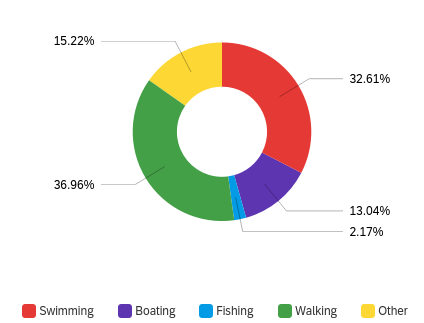Results
Data Collection
Survey
83 anonymous survey responses were collected over a period of 2 months from 11/5/2022 to 10/7/2022.
River water samples
155 sampling kits were dispatched between 16/5/2022 and 22/6/2022 across England.
90 samples were returned back (58% return rate) up until 10/07/2022.
In addition, 10 samples were collected as a pilot study in April 2022 and have been included in this analysis, making 100 samples in total for chemical and microbiological analysis.
Geographic location of survey responses and river water samples collected
There was a large overlap with areas of the country where people responded to the survey and collected samples; however, there were some counties where only surveys were completed, or only samples were taken. The distribution of sample collection as grouped by River Basin District (Environment Agency) was much wider than survey (6/10 survey; 9/10 sampling) with only the South West river basin district not represented in either study. The rivers mentioned in the surveys and the water samples received were mainly located in the central area of England across the Warwickshire, West Midlands, Staffordshire, Derbyshire and South Yorkshire counties, covering three major river basins of the Severn, Humber and Thames rivers.
Survey
- 93% (77/83) of the participants used rivers for recreation.
- 19.5% (15/77) of participants enjoying rivers declared to be usually accompanied by a companion animal (either a dog or a horse) during their activity.
Interactions between humans and companion animals have been proved to influence human microbiome (e.g. skin microbiome)1 and potential transfer of antimicrobial resistant bacteria might occur between humans and animals2.
Swimming and boating activities have a higher risk of people exposure to potential pathogens present in the riverine environment which could then result in either infections or colonisation of human microflora with resistant pathogens. It has been shown that people performing water sports are more likely to show resistant extended-spectrum beta-lactamases (ESBL) E. coli in their gut microbiome linked to environment exposure comparing to the people not directly exposed to costal water 3. Other activities which also involve a closer contact with river water and/or sediment such as fishing, paddling, wading, SUP, playing in the river and canine physiotherapy were also occasionally reported and these activities could also be linked to a higher exposure risk to antibiotic resistance bacteria.
43 different Rivers were recorded, with the most frequently reported being: River Avon (Warwickshire) (9), River Trent (8), River Derwent (7), River Soar (5) and River Rea(4).
Across the rivers mentioned, the majority of participants declared that either a farm (65%) or a wastewater treatment plan (30%) was present within 1 mile of the point of access for the recreational activity, but only 31% were aware of Combined Sewer Outflow within the same mile radius. Although 50% of participant declared that sewage has been previously released in the watercourse, the perception of quality of the rivers they usually access was good (25%) to average (50%). On the contrary, the general overview of quality of English rivers was either average (32%) or poor (45%).
Most of the participants (64%) were aware of existing regulations to limit sewage discharges into rivers, but more interestingly 95% of the participants thought that more control measures should be put in place to limit river pollution.
Chemical and Microbiological Analyses
What we measured
All the samples were tested for:
- presence of coliform bacteria, including the faecal indicator E. coli4.
- quantification of 7 antibiotics usually used to treat human or animal bacterial infections (amoxicillin, ciprofloxacin, erythromycin, oxacillin, sulfamethoxazole, tetracycline, trimethoprim).
- quantification of caffeine and fipronil sulphone - used as markers for human and companion animal presence respectively.
Important notes to read and interpret the data
- It is extremely important to remember that the data reported here are a snapshot of the site sampled at the time of collection only and do not represent the continuous status of the rivers.
- Seasonality and weather conditions (e.g. heavy rain/drought) can affect the presence of faecal coliforms as well as chemicals concentrations in rivers.
- Data have been categorised in groups for easier representation and coloured to visualise patterns more easily across the entire dataset.
- Due to some limitations in the sampling being different from the guidelines reported from the Environment Agency for classification of inland bathing waters4, only presence or absence of the faecal indicator E. coli is reported and not attempt of classification of water quality status was done.
Interactive Map
In the interactive map, you can check the results of the samples analyses.
By clicking on the menu icon on the left side of the map title, you can then select the dataset you would like to visualise.
- Coliform bacteria are reported as CFU/ ml (i.e. colony forming unit per millilitre of water).
- Antibiotics and the other chemicals are reported using nanogram/Litre of water (ng/L) concentrations. For chemicals that could not be quantified “<LOQ” (= below Limit of Quantification) is reported. Similarly, for chemicals that could not be detected, “<LOD” (= below Limit of Detection) is reported.
The recreational activities performed at each site can also be explored and additional notes provide further information of observations noted at the site of collection.
Water samples analyses
Coliforms, E. coli and antibiotic resistance profiles
The majority of the samples (81%) showed low coliform counts, mostly sensitive to the antibiotic tested (amoxicillin, cefotaxime, gentamicin and sulfamethoxazole). Multi-drug resistance was observed for some of the colonies and further analysis will be preformed in the future to better characterise some of these isolates.
E.coli was identified in 36 samples, mainly in samples with higher coliform bacteria counts. In this case, the presence of E. coli does not determine the status of the water as the technique used for the bacteria detection was different from the one used by the Environment Agency to qualify inland bathing waters.
The source of E. coli contamination is difficult to determine. However, for some of the samples, the presence of waste water treatment plant upstream of the sampling site or animals (farms) in the surrounding areas, would represent the most likely source.
Antibiotic pollution in English rivers
The 7 antibiotics selected in this study have been quantified individually and in the map the antibiotic load as a sum of all the quantified antibiotics is reported.
- For 3% of samples, the selected antibiotics were undetectable.
- 72% of samples showed a low antibiotic load (up to 260 ng/L).
- 22% of samples had a middle-low antibiotic load (< 1mg/L).
- 3% sample had a middle-high antibiotic load (> 1.3 mg/L).
Selection of antibiotic resistance in pathogens?
It is worth noticing that the samples presenting E. coli showed low levels of antibiotics. Presence of antibiotics in the environment play an important role in driving selection and potential spreading of antibiotic resistance across bacteria in the environment, including potential pathogens that are present in it5-7.
References and Further Readings
1 Song, S. J. et al. Cohabiting family members share microbiota with one another and with their dogs. Elife 2, e00458, doi:10.7554/eLife.00458 (2013).
2 Pomba, C. et al. Public health risk of antimicrobial resistance transfer from companion animals. J Antimicrob Chemother 72, 957-968, doi:10.1093/jac/dkw481 (2017).
3 Leonard, A. F. C. et al. Exposure to and colonisation by antibiotic-resistant E. coli in UK coastal water users: Environmental surveillance, exposure assessment, and epidemiological study (Beach Bum Survey). Environ Int 114, 326-333, doi:10.1016/j.envint.2017.11.003 (2018).
4 Environment Agency. Bathing Water Quality
5 Borsetto, C. et al. Impact of sulfamethoxazole on a riverine microbiome. Water Res 201, 117382, doi:10.1016/j.watres.2021.117382 (2021).
6 Bengtsson-Palme, J. & Larsson, D. G. Concentrations of antibiotics predicted to select for resistant bacteria: Proposed limits for environmental regulation. Environ Int 86, 140-149, doi:10.1016/j.envint.2015.10.015 (2016).
7 Larsson, D. G. J. & Flach, C. F. Antibiotic resistance in the environment. Nat Rev Microbiol 20, 257-269, doi:10.1038/s41579-021-00649-x (2022).
Acknowledgements
Thanks to the University of Warwick, Enhancing Research Culture Fund (UKRI Research England), for the funding to establish this citizen science project.
Thanks to all the participants who helped by replying to the survey and/or submitting the samples. Your contribution was fundamental to the success of this project.





